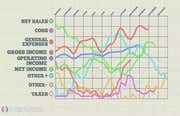|

|
The current ratio measures the ability of a company to cover its short-term liabilities with its current assets.
The formula is:
-
Current assets divided by current liabilities
As an example, a company with $10 million in current assets and $5 million in current liabilities would have a current ratio of 2.0 times.
A current ratio of 1.0 or greater is an indication that the company is well-positioned to cover its current or short-term liabilities.
A current ratio of less than 1.0 could be a sign of trouble if the company runs into financial difficulty.
Cautions in using this ratio
When looking at the current ratio, investors should be aware that this is not the whole story on company liquidity. It’s also important to understand the types of current assets the company has and how quickly these can be converted into cash to meet current liabilities.
For example, how quickly can the company collect all of its outstanding accounts receivables? An analyst would want to look at the company’s days sales outstanding which is a measure of how long it takes the company to receive payment after a sale is made.
For companies with inventory, how quickly can this inventory be liquidated should the need arise and what percentage of the inventory’s value would the company be likely to receive? Looking at the company as a going concern, an analyst would want to calculate the company’s inventory turnover ratio, a measurement of how long it takes a company to turnover or sell its inventory.
The current ratio inherently assumes that the company would or could liquidate all of most of its current assets and convert them to cash to cover these liabilities. In reality this is unlikely if the company is to remain as a going concern. A certain level of working capital will still be needed.
Companies with a seemingly high current ratio may not be safer than a company with a relatively low current ratio. Beyond just looking at the current ratio, an analyst would need to look at the composition and quality of the company’s current assets. The current ratio is just one of many financial indicators that potential investors and creditors will need to analyze.
Liquidity Measurement Ratios: Quick Ratio
-
 Investing
InvestingRatio Analysis
Ratio analysis is the use of quantitative analysis of financial information in a company’s financial statements. The analysis is done by comparing line items in a company’s financial ... -
 Investing
Investing6 Basic Financial Ratios And What They Reveal
These formulas can help you pick better stocks for your portfolio once you learn how to use them. -
 Investing
InvestingKey Financial Ratios for Retail Companies
Using the following liquidity, profitability and debt ratios, an investor can gather deeper knowledge of a retail company's short-term and long-term outlook. -
 Investing
InvestingUnderstanding financial liquidity
Financial liquidity comes into play for companies, your personal finances, investing, and the financial markets. However, assets and investments have varying liquidity levels. -
 Investing
InvestingHow to Analyze a Company's Financial Position
Find out how to calculate important ratios and compare them to market value. Using company financial analysis, we can analyze a firm's financial position. -
 Investing
InvestingSysco and Other Big Movers In Services
The market has been slipping so far today. The Nasdaq has fallen 0.3%; the S&P 500 has fallen 0.4%; and the Dow has declined 0.5%. The Services sector (IYC) is currently lagging behind the overall ... -
 Investing
InvestingKey Financial Ratios to Analyze the Hospitality Industry
Understand the hospitality industry and the types of companies that operate within it. Learn about key financial ratios used to analyze the industry. -
 Investing
Investing5 must-have metrics for value investors
In this article, we outline the five ratios that can help value investors find the most undervalued stocks in the market.


